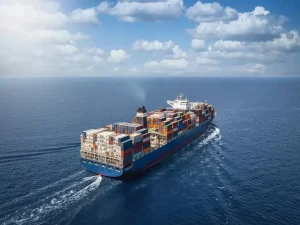New Delhi – India’s economic growth has long been hindered by high logistics costs, making it one of the most expensive nations in terms of moving goods. To address this issue and enhance the capabilities of its maritime sector, the Government of India has introduced the Coastal Shipping Bill in Parliament. The Bill is poised to revolutionize the country’s shipping industry by reducing logistics costs, increasing the efficiency of cargo movement along the coast, and making India a more attractive hub for global trade.
The introduction of the Coastal Shipping Bill marks a pivotal moment in India’s maritime strategy, aiming to tap into the potential of coastal shipping, one of the most eco-friendly and cost-effective forms of transportation. In this article, we will explore the details of the Coastal Shipping Bill, its objectives, and the profound impact it will have on India’s economy and logistics sector.
The Need for the Coastal Shipping Bill: Reducing High Logistics Costs

India has long faced high logistics costs, which are a significant barrier to the competitiveness of its industries on the global stage. According to estimates, logistics costs in India account for about 13-15% of the GDP, compared to around 8-10% in developed economies. One of the key reasons for this disparity is the underutilization of India’s coastal shipping potential, which has remained largely untapped despite the country’s long coastline.
The Coastal Shipping Bill aims to address this gap by promoting the use of coastal shipping for both domestic and international trade. Coastal shipping offers several advantages, including lower fuel costs, reduced road congestion, and a smaller carbon footprint. The Bill seeks to reduce the logistical burden on roads and railways, which are often overburdened, particularly in the movement of goods between coastal cities.
Objectives of the Coastal Shipping Bill: Key Features and Goals
The Coastal Shipping Bill has been introduced with several key objectives in mind. These include:
1. Reducing Logistics Costs in India
One of the primary goals of the Coastal Shipping Bill is to significantly reduce logistics costs in India. By encouraging the use of ships for the transportation of goods along the country’s vast coastline, the government aims to provide an alternative to road and rail transport, which are often expensive and less efficient. Coastal shipping can transport large quantities of goods at a lower cost, which could result in savings for businesses and, ultimately, lower prices for consumers.
2. Enhancing the Maritime Sector’s Infrastructure
The Bill also aims to improve the infrastructure related to coastal shipping. This includes upgrading ports, expanding the capacity of existing facilities, and building new terminals to handle larger volumes of cargo. By enhancing port infrastructure, the government seeks to make India’s coastal ports more efficient and capable of handling modern shipping vessels. This will not only facilitate smoother cargo movement but also boost the competitiveness of India’s ports in the international shipping market.
3. Boosting Eco-Friendly Shipping Alternatives
In line with global environmental goals, the Coastal Shipping Bill also aims to promote greener shipping options. Coastal shipping is considered one of the most environmentally friendly ways of transporting goods due to its lower carbon emissions compared to road and rail transport. By shifting more cargo to ships, the Bill will help reduce India’s overall carbon footprint and contribute to the nation’s sustainability goals.
4. Encouraging Public-Private Partnerships (PPP)
The introduction of the Coastal Shipping Bill also envisions greater public-private collaboration in the maritime sector. The government aims to attract private investment to improve shipping and port infrastructure. Through such collaborations, India hopes to bring in cutting-edge technology and expertise to enhance the efficiency of its maritime operations.
Key Provisions of the Coastal Shipping Bill: What Does It Entail?


The Coastal Shipping Bill is structured to cover several critical areas of India’s maritime logistics sector. The Bill outlines the legal framework for coastal shipping, port operations, and regulatory measures. Some of the most important provisions include:
1. Regulation of Coastal Shipping Activities
The Bill lays down comprehensive regulations for the operation of coastal shipping services, including guidelines for the registration of ships, safety measures, and the qualification of operators. By establishing a regulatory framework, the government ensures that all players in the industry comply with safety and environmental standards, promoting a safe and sustainable shipping environment.
2. Incentives for Coastal Shipping Operators
To encourage the growth of the coastal shipping industry, the Bill introduces several incentives for operators. These include tax exemptions, subsidies for ship maintenance, and financial assistance for upgrading vessels. Such incentives are designed to lower operational costs for shipping companies, making it more attractive to invest in coastal shipping.
3. Development of New Ports and Expansion of Existing Ones
The Bill calls for the creation of new ports along the coastline, focusing on areas that are currently underserved. It also emphasizes the expansion and modernization of existing ports to handle larger cargo volumes and accommodate newer, more advanced vessels. This infrastructure development will significantly boost the efficiency of India’s shipping industry and its ability to handle international trade.
4. Integration with National Logistics Policy
The Coastal Shipping Bill is closely linked to India’s broader National Logistics Policy, which aims to improve the overall logistics infrastructure and reduce costs. The Bill complements this policy by offering a viable alternative to overburdened rail and road systems, thereby optimizing the flow of goods across the country.
Impact of the Coastal Shipping Bill on India’s Economy


The introduction of the Coastal Shipping Bill is expected to have far-reaching effects on India’s economy. These impacts will be felt across various sectors, from manufacturing and trade to employment and the environment.
1. Boosting India’s Trade Competitiveness
By reducing logistics costs, the Bill will make Indian goods more competitive in international markets. Lower transportation costs will give Indian exporters an edge in global trade, potentially increasing the volume of exports. This will not only benefit industries such as manufacturing, textiles, and agriculture but also enhance India’s standing in international trade rankings.
2. Creating Job Opportunities
The expansion of the coastal shipping sector is expected to create a large number of job opportunities, both directly and indirectly. New ports, terminals, and infrastructure projects will require skilled labor, while the increased demand for shipping services will lead to the creation of jobs in logistics, management, and operations. Additionally, the growth of the maritime industry could encourage the development of related sectors, such as shipbuilding and maintenance.
3. Environmental Benefits
With India aiming to cut its carbon emissions and promote sustainability, the Coastal Shipping Bill will contribute significantly to these goals. Coastal shipping is a more energy-efficient mode of transportation, and by shifting a larger portion of cargo to ships, India can reduce its reliance on road and rail transport, both of which produce higher levels of carbon emissions.
Challenges in Implementing the Coastal Shipping Bill
While the Coastal Shipping Bill promises significant benefits, its implementation will face several challenges. Key obstacles include:
-
Port Infrastructure Limitations: Despite plans to upgrade ports, many of India’s ports are still underdeveloped and need substantial investment to handle larger ships and higher volumes of cargo.
-
Regulatory Hurdles: The introduction of new regulations can often face resistance from industry players, and the complexity of implementing them across multiple jurisdictions may slow down progress.
-
Private Sector Participation: Attracting private sector investment in a sector that is traditionally government-controlled could take time and require significant incentives.
Also Read: Bold Move: India Imposes 100% Tariff on Agricultural Imports from US
Final Remarks: A Step Towards Transforming India’s Maritime Sector
The introduction of the Coastal Shipping Bill is a crucial step in transforming India’s logistics and maritime sectors. By reducing logistics costs, improving infrastructure, and promoting sustainable shipping practices, the Bill addresses some of the most pressing challenges faced by the Indian economy today. If successfully implemented, it has the potential to revolutionize the country’s trade capabilities, creating jobs, boosting exports, and contributing to environmental sustainability.
As the government continues to work on implementing the provisions of the Bill, stakeholders in the shipping and logistics sectors will need to collaborate to overcome the challenges and make the vision of a more efficient, competitive, and eco-friendly maritime sector a reality.

